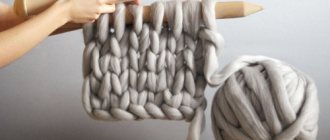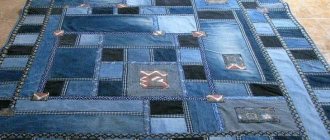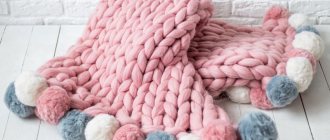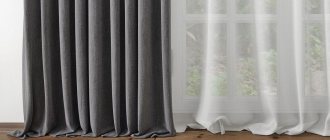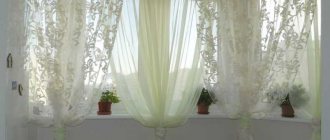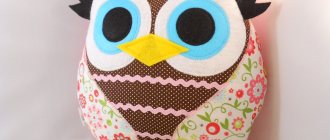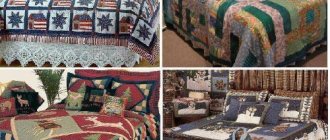Knitting ten stitches using a knit stitch is a very interesting type of needlework. Using this method, you can create a beautiful and practical blanket from leftover knitting threads. Working using the knit stitch method is not at all difficult.
A small blanket knitted with spiral knitting using the “10 loops” method
Schemes of work
You need to knit such a blanket using one of the simple methods - garter stitch with ten stitches.
Garter stitch with knitting needles - diagram and description
In this case, the first front loop must be constantly removed, and the tenth one can be made using any convenient method, but so that slices of the side braid are formed from the edge. This is necessary to make it easier to attach the strips to each other.
An example of knitting short rows - cast on loops, knit 2 rows in garter stitch
In the third row we knit 8 loops, and leave 4 on the left knitting needle
The initial tape must be knitted, creating loops in a pigtail - both along the face and on the wrong side. If the plaid is designed to be square, the knit stitch should be created using 9 knitting furrows.
In order to turn the work, we throw the working thread onto the left knitting needle over the last loop and remove this same loop onto the right knitting needle as a purl
Then we take the working thread behind the loop, and return the loop itself to the left knitting needle
In this way we wrapped the outer loop on the left knitting needle - this is necessary so that there is no hole at the turning point
In order to knit a rectangular blanket, the sections of the side braid should be made longer. For example, for needlework measuring 200x150, it is necessary that during the work process the initial tape comes out 50 centimeters long.
Plaid 10 loops: description
The product can be of any size. You can knit a bedspread, a warm blanket, a small throw for a chair, and a knitted tablecloth for the table.
Beautiful children's blanket and blouse included, knitted from squares “10 loops”
Multi-colored threads for such a blanket
Colors can also be very diverse. The most popular options:
- two-color,
Two-color square blanket “10 loops” - multi-colored with iridescence,
Chic multi-colored plaid with iridescence looks very beautiful - multi-colored without shimmer.
Square multi-colored blanket “10 loops” without iridescence
The choice of color scheme depends on the personal preferences of the needlewoman and on the availability of knitting threads. The most sophisticated option is a multi-colored blanket with iridescence. It will fit perfectly into any interior, will look absolutely not old-fashioned and will add charm and comfort to any room.
You can knit the original round version of the blanket “10 loops”
And the correct choice of color will allow you to make the most of the remains of multi-colored knitting thread lying around at home.
Any multi-colored threads are perfect for such a blanket.
Knitting process
Cast on 10 loops and knit the initial ribbon using garter stitch (knit stitches across the face and back)
The crucial moment of the whole process is the first corner. It is necessary to take into account the shift by 1 loop, and knit the corner so that there are no holes between adjacent loops. To avoid confusion, the corner can be knitted in 9 stitches from left to right, then the same number in the opposite direction.
We tie the full first corner, counting down
Next you need to tackle the second corner. In the process, do not forget about the displacement and the fact that the first loop of the braid must be removed.
Let's start knitting the second corner, counting from 9 to 1
Once the two corners are done, it's tape time. It must be tied while simultaneously attaching the braids of the main fabric. To do this, you need to pull the front loop through the previously removed loop number ten.
We tie the corner, making increments, count from 1 to 9 - the second corner is ready
What if it’s crocheted?
We crochet either only under the back part of the braid, or under both of its parts. In the first case, a thin knitting scar is obtained, in the second, the scar will be dense, well defined, and voluminous.
Multi-colored children's blanket “10 loops” crocheted with Tunisian crochet
When knitting under the back lobe, the wrong side turns out to be less voluminous and more pleasant to the touch. However, a bipartite scar will look much neater. Which method to choose is a personal matter for each needlewoman.
We begin knitting the ribbon, simultaneously attaching it to the side braid of the knitted fabric; such a rib is obtained if you knit a front loop under both sections of the side braid
Wrong side – there is a small groove in place of the hem
If you knit under both sections of the side braid, then the rib is made from two tracks with facial loops
We do the rest of the work in a spiral, constantly measuring the same ten loops. It is rational to stick to one direction - traditionally such a blanket is knitted counterclockwise. In this case, the product turns out to be very neat, and, what is important for inexperienced needlewomen, it is easy to unravel correctly if a mistake is made during the knitting process.
Now we knit the corner again in a spiral, attaching the knitting to the edge braid of the knitted
The second square is ready, we continue to knit, forming corners and joining knitting on straight sections
Possible colors
This blanket will look great in any color. But before we start work, we need to decide what kind of product we want to get in the end. The most popular options:
- of two colors;
- from several different balls of thread with iridescence;
- from several different balls of thread without overflow.
Some errors
What mistakes are often made when using the 10 loops method? The first is the incorrect counting of the loops themselves. A common mistake is not slipping the first stitch when completing a row. Then you have to unravel the yarn and start again.
Also, mistakes are made when knitting a corner. The whole thing is spoiled by loose rows - the blanket not only loses its functions as a warm thing, but its appearance also deteriorates significantly. In order to prevent stretching, it is necessary to use knitting in short rows - it turns out dense, and it is easier to make corners with such knitting.
Such needlework is a wonderful pastime for any housewife and an excellent method for producing practical, comfortable, stylish and warm products.
The edge of the blanket can be crocheted with fans
Use Cases
If suddenly there are several skeins of yarn left from previous projects and you don’t want them to lie idle, but you doubt whether such a blanket will be useful in the household, we offer several of the most common options for use:
- a blanket of any size can be used for its real purpose, that is, as a blanket;
- as a bedspread for a bed or sofa;
- If the size of the product is small, it will be useful as a seat on a chair.

